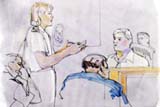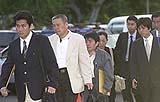 Court of Inquiry opening remarks Court of Inquiry opening remarks
 Graphic: Inside the Court of Inquiry Graphic: Inside the Court of Inquiry
 Hawaiian ceremony honors Ehime Maru victims Hawaiian ceremony honors Ehime Maru victims
 Uwajima City mayor seeks full disclosure of events Uwajima City mayor seeks full disclosure of events
 A Tribute to the Missing A Tribute to the Missing
 Previous stories Previous stories
By Dan Nakaso
Advertiser Staff Writer
Vice Adm. John B. Nathman today opened one of the Navy’s rare courts of inquiry to try to find out how the fast-attack submarine USS Greeneville crashed into a Japanese training vessel on Feb. 9, killing nine people off the coast of O‘ahu.
“The consequences of the collision have impacted the lives of both Japanese and American families," Nathman told the packed courtroom at the Pearl Harbor naval base. "While this inquiry cannot change what has happened, a more thorough understanding of what occurred can prevent its reoccurrence.”
 |
Cmdr. Scott Waddle, extreme left, listens to Lt. Cmdr. Kimberlie Young, counsel for the parties, during court of inquiry proceedings today.
Associated Press/Lynn Matsuoka |
The court of inquiry will end with recommendations – no verdicts or immediate changes in Navy policy. But three, perhaps four, naval careers are on the line, as well as Navy policies that allowed civilians to be in the control room of the Greeneville at the time of the collision with the fishing vessel Ehime Maru. Thirty-five people were aboard the Japanese ship, which was used to train high school students how to fish. Nine are still missing and presumed dead.
At the heart of the inquiry are the roles of the Greeneville’s captain, Cmdr. Scott Waddle, the executive officer, Lt. Cmdr. Gerald K. Pfeifer, and the officer of the deck, Lt. j.g. Michael J. Coen.
Nathman, under questioning by the officers’ attorneys for possible challenges to the board members, said that his reaction to the collision was “it’s a bad day for the Navy and a bad day for the captain. He’s going to have to answer to a lot of questions.
“As a captain, you’re responsible for the conduct of your crew and your ship,” Nathman said. “As a captain, you have to look after your ship and you have to look after your crew.”
Asked about his attitudes toward the role of executive officers, Nathman told Pfeifer’s attorney that an executive officer has an obligation to speak his mind “if he feels like things aren’t going particularly well ...You need to speak up.”
 |
Relatives of the missing men and boys from the Ehime Maru arrive at the court of inquiry this morning.
Richard Ambo • The Honolulu Advertiser |
Nathman was the first to arrive at the naval courthouse before 7:15 a.m. Next came Waddle in dress whites walking hand-in-hand with his wife, Jill, and accompanied by Charles Gittins, his civilian attorney. Waddle’s father, Dan, followed close behind. None of them said anything or acknowledged the news media horde as cameras flashed. They walked into the courthouse with their eyes down.
The families of the Japanese victims followed about 7:30 a.m., and then a group of Japanese officials, including Yoshio Mochizuki, the parliamentary vice minister of foreign affairs, to whom Waddle apologized last week.
Rear Adm. Charles Griffiths Jr., who conducted the initial investigation, was the only person to acknowledge the media, greeting the group with a cheery, “Good morning. How are you doing?” before entering the courthouse.
More than 100 members of the media, many of them Japanese, gathered outside the courtroom as the sun rose, but they were only a portion of the more than 400 at Pearl Harbor to cover the trial. They were kept about 12 feet away from the walkway behind a metal barrier.
The court of inquiry will take the world into the Greeneville’s control room that day as two civilians sat at critical controls, under the supervision of Navy personnel. The presence of the civilians and the perceived lack of a rescue attempt by the Greeneville crew have strained U.S.-Japan relations despite a series of apologies from President Bush on down.
For the next three to four weeks, a crush of media from 44 news organizations will document the court’s investigation into the collision between the Greeneville and the 174-foot Ehime Maru.
Courts of inquiry, the Navy’s highest administrative form of investigation, are used for the most serious accidents.
Nine aboard the Ehime Maru who remaining missing include four teenagers.
The Ehime Maru sunk within 10 minutes and remains on the ocean floor 2,003 feet down.
Calling for a court of inquiry is “quite a big deal,” said Eugene Fidell, a former Coast Guard lawyer and founder and president of the National Institute of Military Justice. “It indicates the high stakes that are involved for both the Navy’s procedures and the potential implications for U.S.-Japanese relations.”
In his order creating the court of inquiry, Adm. Thomas Fargo, commander of the U.S. Pacific Fleet, also directed the court to investigate the possible role of Capt. Robert L. Brandhuber, chief of staff for the fleet’s submarine force. Brandhuber was serving as the Navy escort to the 16 civilian guests.
Unlike Waddle, Pfeifer and Coen, Brandhuber is not a party to the inquiry. But Fargo directed the court to examine “whether he, as the senior officer onboard the USS Greeneville on 9 February 2001, was in a position to intervene and prevent the chain of events leading to the collision.”
A separate investigation underway by the National Transportation Safety Board found that the Greeneville was using only its passive sonar, not its more sensitive active sonar to search for surface ships before executing a dramatic “main emergency ballast blow” and crashing into the Ehime Maru.
The NTSB investigation also found that the Greeneville had identified a sonar contact an hour before the collision. The contact was later determined to be the Ehime Maru.
And a sailor plotting surface ships with pencil and paper told NTSB investigators that he was distracted by some of the civilians, although he continued to input the information into the Greeneville’s computer system.
Advertiser Washington correspondent Susan Roth contributed to this report.
|


